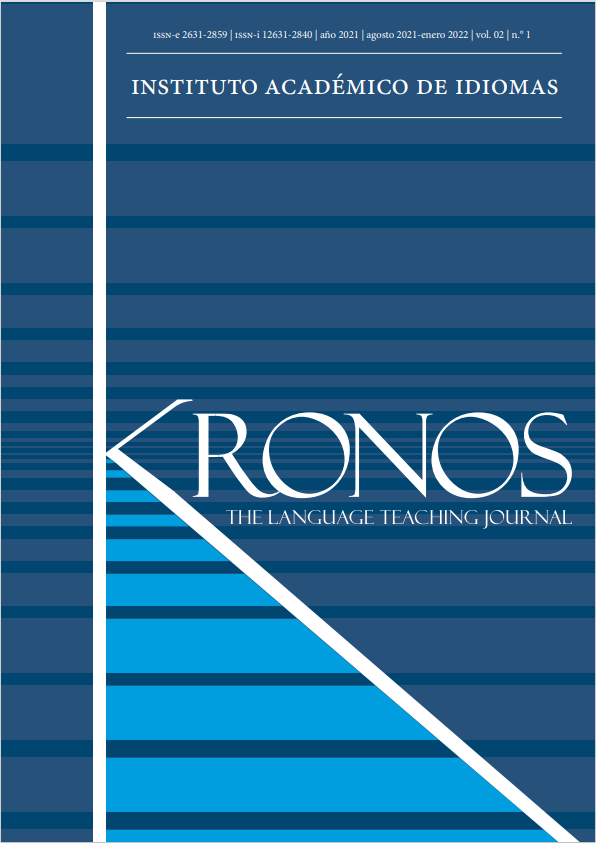Factores que motivan a los profesores de inglés de las escuelas públicas ecuatorianas a realizar code-switch (cambiar de un idioma a otro) en el aula de inglés como lengua extranjera
DOI:
https://doi.org/10.29166/kronos.v2i1.3032Palabras clave:
Sociolingüística, factores para cambiar de código, enseñanza del idioma inglés como lengua extranjera, docentes de inglés de instituciones públicas del EcuadorResumen
El cambio de código es un fenómeno sociolingüístico que usualmente ocurre in comunidades bilingües o multilingües. Con respecto al contexto de la enseñanza del idioma inglés, parecería que el cambio de código también ocurre en las aulas de la enseñanza del idioma inglés como lengua extranjera. Por lo tanto, este artículo intenta descubrir y describir los factores que motivan a los docentes ecuatorianos de inglés a cambiar de código, así como establecer las bases para futuras investigaciones sobre los efectos y el papel que el idioma materno debería jugar en el aula de enseñanza del idioma inglés como lengua extranjera. Este estudio descriptivo, combinado y etnográfico recopiló datos por medio de encuestas de 6 preguntas enmarcadas en la escala de Likert, las cuales fueron contestadas por 17 docentes ecuatorianos de inglés. Los resultados muestran que los factores que los motivan a cambiar de código están relacionados con propósitos afectivos y pedagógicos; no obstante, parecería que su uso no es planificado ni aplicado para alcanzar propósitos pedagógicos que les permitan conocer cómo y cuándo el cambio de código podría mejorar el proceso de adquisición de un segundo idioma.
Descargas
Citas
Azlan, N. M., & Narasumanb, S. (2012). The Role of Code-Switching as a Communicative Tool in an ESL Teacher Education Classroom. 6th International Conference on University Learning and Teaching (pp. 458-467). Selangor, Malaysia: Academy of Language Studies, Universiti Teknologi MARA.
Bernal, C. ( 2010). Metodología de la Investigación: Tercera edición. Bogota: Pearson.
Brown, H. D. (2000). Teaching by Principles: An interactive Approach to Language Pedagogy. London: Logman.
Cambridge. (2020, January 18). Cambridge Dictionary. Retrieved from https://dictionary.cambridge.org/es/diccionario/ingles/translation
Carabajo, Í. R., González, S. D., & Paccha, M. d. (2020). Advantages and Disadvantages of Teaching English as a Second Language in a Spanish-speaking Country: A Case Study at the Coastal Zone in Ecuador (Vol. 4 (31)). Santa Elena: Pro Sciences. doi:https://doi.org/10.29018/issn.2588-1000vol4iss31.2020pp72-78
Chowdhury, N. (2013). Classroom Code Switching of English Language Teachers at Tertiary Level: A Bangladeshi Perspective. . Stamford Journal of English, 7, 40-61. Retrieved from https://doi.org/10.3329/sje.v7i0.14462
Currículo. (2016, February 2). Mineduc. Retrieved from Currículo de Lengua Extranjera Inglés: https://educacion.gob.ec/curriculo-lengua-extranjera/
Fareed, M., Humayuny, S., & Akhtar, H. (2016). English Language Teachers' Code-switching in Class: ESL Learners' Perceptions. Journal of Education & Social Sciences, 4 (1), 1 -11. doi:10.20547/jess0411604101
García, O. (2017, November 11). Translanguaging during the Multilingualism. Diversity Lectures. Retrieved from https://www.youtube.com/watch?v=5l1CcrRrck0
Grosjean, F. (1982). Life with two language. An introduction to bilingualism. Cambridge: Harvard University Press.
Hamadi, H., & Sarem, S. N. (2012). A Closer Look at some Reasons behind Code-switching: A Case of Iranian EFL Classrooms. ELT Voices - India, 90 - 102.
Holmes, J. (2013). An Introduction to Sociolinguistics (Fourth ed.). New York: Routledge.
Itmeizeh, M., Ibnian, S. S., & Sha'fout, M. (2017). Code- Switching among Teachers of English Language Service. Asian Journal of Humanities and Social Studies, 05. Retrieved from https://www.ajouronline.com/index.php/AJHSS/article/view/4892
Johansson, S. (2014). Code-switching in the English Classroom: What teachers do and what their students wish they do. Semantic scholar.
Karakaya, M., & Dikilitaş, K. (2020). Perceptions of the students and the teachers towards the use of code switching in EFL classrooms. The Literacy Trek, 40 - 73.
Kim, E. (2006). Reasons and Motivations for. Issues in EFL, 4 (1), 43 - 61. Retrieved from https://www.semanticscholar.org/paper/Reasons-and-Motivations-for-Code-Mixing-and-Kim/ae406457161f9cccea34a54fba06c67246de2d72
Krashen, S. D. (1981). Second Language Acquisition and Second Language Learning. California: Pergamon Press Inc.
Krashen, S. D. (2021, January 20). Bilingualism in Second Language Acquisition. (J. Matts, Interviewer) Retrieved from https://www.youtube.com/watch?v=tWr4bMaRLKM
Krashen, S. D., & Terrell, T. D. (1998). The Natural Approach: Language Acquisition in the Classroom. London: Prentice Hall ELT.
Mahdi, A., & Almalki, M. S. (2019). Teachers’ Perceptions towards Pedagogical Implications of Code Switching: Saudi EFL Classroom Context in Focus. International Journal on Studies in English Language and Literature (IJSELL), 7 (1), 1-9. doi:http://dx.doi.org/10.20431/2347-3134.0703001
Payne, M., & Contreras, J. P. (2019). Ecuadorian Students’ Perception on the Use of Translation in the EFL Classroom. Studies in English Language and Education, 6 (1), 61 - 70. doi:https://doi.org/10.24815/siele.v6i1.12072
Pollard, S. (2002). The Benefit of Code Switching within a Bilingual Education Program. Honors Project, Paper 2. Retrieved from http://digitalcommons.iwu.edu/hispstu_honproj/2
Redouane, R. (2012). Linguistic constraints on code-switching and code-mixing of bilingual Moroccan Arabic-French speakers in Canada. Proceedings of the 4th International Symposium on Bilingualism, 1921 - 1933. Retrieved from http://www.lingref.com/isb/4/149ISB4.PDF
Ritchie, W. C., & Bathia, T. K. (2008). Social and Psychological Factors in Language Mixing. The Handbook of Bilingualism, 336 - 352. doi:10.1002/9780470756997.ch13
Rivera, W. (2017). Perspectivees of Code-switching in EFL A1 Learners of an Ecuadorian Public University. Guayaquil: Escuela Politécnica del Litoral: Facultad de Ciencias Sociales y Humanísticas.
Vergara, A. V. (2016). Code-Switching: Uses and perceptions an the EFL Classroom at Uniminuto. Bogota: Corporación Universitaria Minuto de Dios. doi:http://hdl.handle.net/10656/4453
Wei, L. (2016, December 06). Translanguaging as a Theory of Language. Retrieved from https://www.youtube.com/watch?v=fnOx8GjPvj4
Weinreich, U. (1953). Languages in contact, findings and problems. New York, NY: Linguistic Circle of New Yo. New York: Linguistic Circle of New York.
Yao, M. (2011). On Attitudes to Teachers’ Code-switching in EFL Classes. World Journal of English Language, 01. doi:https://doi.org/10.5430/wjel.v1n1p19
Descargas
Publicado
Cómo citar
Número
Sección
Licencia
Derechos de autor 2021 Wellintong Segundo Intriago Alcivar, Delia Hidalgo

Esta obra está bajo una licencia internacional Creative Commons Atribución-NoComercial-CompartirIgual 4.0.












